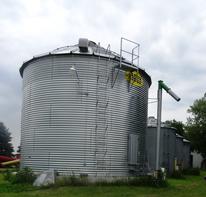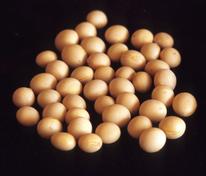By Gigi DiGiacomo
Edited by Kristine Moncada, Craig Sheaffer and Nicole Tautges
Jay Peterson currently works full-time managing an electrical contracting business while farming 230 acres of family land that he rents from his mother. The Peterson land is owned by Jay’s mother but eventually will be passed on through an estate that includes Jay and his five sisters. Jay’s sisters do not have an interest in farming. Therefore, Jay’s goal is to accumulate funds and build equity over the next 5 to 7 years so that he qualifies financially to purchase the farm.
Jay farms 230 acres of prime cropland that has been in his family for three generations. “I’ve been helping to farm this land since I was a little boy,” says Jay. He currently rents the land from his mother and manages it using a conventional corn-soybean rotation on most fields just like his dad used to do. However, Jay’s also doing a few things differently: investing in cover crops, using seed that is not genetically modified (GMO), and forward-contracting his crops to manage risk. He’s also giving organic farming a try on 34 acres and may transition the whole farm if he can generate a profit doing so.
After doing a financial analysis, Jay is convinced that he could turn a good profit by managing all of the land organically. A four year income projection suggests Jay would net $443 per acre each year with a diverse organic rotation that includes corn, soybeans, wheat and alfalfa compared to $107 per acre annually over the same period when managing a conventional 50-50 corn-soybean rotation.
The organic rotation would generate more income thanks in large part to price premiums that are paid for organic crops. Organic grain and livestock products are in strong demand in the United States. In fact, demand has well outpaced supply, leading to price premiums for organic corn, soybeans, wheat and oats that are 2-3 times that of conventional commodities.
So why the concern about profitability? Jay knows the farm will make money once certified organic. However, it’s the transition period that troubles him.
Jay earns approximately $107/acre annually with a conventional corn/soybean rotation. With the same rotation and a mix of transitional premiums (food-grade soybeans) and conventional prices (feed grade corn), Jay would expect to lose $86/acre or more during transition. “Farming under transition is difficult because you are still in the same game as everyone else [who farms conventionally] but with reduced yields,” Jay explains saying that his soybean yields dropped 32 percent on the half of his transitional land due to wet conditions, weed pressure and three hail storms. “You need premiums to make up for yield losses,” says Jay, also explaining that crop insurance for transitioning crops is not a viable financial safety net at this point in time.
Farmers regularly experience yield drops during transition while building soil fertility naturally through the use of crop rotations, green manures, cover crops, and other methods. Additionally, there is a learning curve associated with managing weeds and pests without the use of chemicals.
Some farmers can risk income losses during the transition years because they make up for them once they are certified. It’s common for farmers to take out a loan during transition to help pay for operating expenses and cover any yield-related losses. Jay has an operating loan but his goal is to make the farm financially sustainable during transition and beyond. Equally important is the short time horizon during which Jay is looking to build equity so that he can purchase the family farm. He can’t afford any “loss years.” Instead, Jay’s plan is to make up for transition-related yield losses by marketing his transitional, non-GMO grain for a premium in “identity preserved” markets.
All farmers grapple with marketing issues, but the limited transitional contracts makes this task even more difficult. There exists a ready market for conventional grains; farmers always have the option of selling crops straight out of their fields to a local elevator in what is called the “spot” or “cash” market. This is not an option for identity preserved producers. Most grain elevators do not handle identity preserved grains and oilseeds, buyers are difficult to identify, and price reporting for organic and other identity preserved commodities is sparse.
Jay has used forward contracts and has ample storage on farm if needed. However, he’s having trouble identifying specialty crop buyers who offer premiums for some of the crops he’s planning to grow during transition and he doesn’t always know when to lock in a contract price (i.e. knowing what price the market will bear). “Price is a moving target [in the transitional and organic sectors],” says Jay. By comparison, the conventional market is fully transparent with commodity prices published daily by the USDA Agricultural Marketing Service and buyers available at every local grain elevator. Please visit organictransitions.umn.edu for our module on organic marketing.
Like other farmers, Jay has seen his yields drop substantially during the transition of his first 34 acres due to a variety of factors. If he transitions the rest of his acreage, it might be impossible to make a profit for those three years. If Jay can’t find a way to make it work financially, he’s unlikely to convert the remaining 196 acres to organic management. Jay is now convinced that he will need to secure price premiums for his transitional crops if he’s going to financially survive the three-year transition period from conventional to organic management. Currently Jay markets his transitional food-grade soybeans as identity preserved using a forward contract with a buyer willing to pay a 40% premium above conventional prices. He receives this premium because the soybeans are grown with non-GMO seed. “I earned $4.85/bu above the conventional price for my soybeans in 2016,” says Jay. That translates into $90/acre net income on transitional ground.
Marketing transitional corn, however, is proving more complicated than Jay expected. Jay has not been able to connect with any buyers offering identity preserved crop contracts or premiums for transitional corn. He could sell the corn conventionally, but doing so could cost him $155/acre.
Alternative Marketing Strategies
There is no obvious silver bullet to solve Jay’s marketing problem. However, he is considering one or a combination of the following marketing strategies to secure a better price for his crops during transition: 1) altering his crop rotation to include a second year of soybeans; 2) exploring contracts for “Certified Transitional” or non-GMO products; 3) joining a marketing organization or hiring a broker to secure better paying contracts for all crops; and/or 4) making better use of on-farm storage.
Alter crop rotation to include a second year of soybeans
Jay might consider altering his transition rotation to include a second year of soybeans on a portion of his land if there continues to be a strong market and premiums for transitional and/or non-GMO soybeans. National Organic Program rules require farmers to rotate their annual crops every year once certified, but this particular rule does not apply during transition. Assuming he is able to secure the same transitional, non-GMO soybeans contract price as he did in 2016, Jay would only need to grow soybeans two years in a row on 30 percent of his land to break even. Jay will not be able to apply synthetic pesticides during transition and would likely experience pest pressure when growing soybeans two years in a row so he’ll want to carefully consider whether or not to plant more soybeans.
Explore contracts for “Certified Transitional” or Non-GMO Products
New markets are developing for transitional crops as manufacturers and end users grow markets for foods made with transitional grains, oilseeds, and other farm products. The “Certified Transitional” program, administered by organic certifying agencies and overseen by the USDA, certify operations as transitioning to organic after one year of transition. Most buyers of “Certified Transitional” crops are looking for food-grade products, although markets for feed-grade non-GMO grains are growing.
Join a marketing organization or hiring a broker
“I listen to the [commodity] markets every morning,” says Jay. “But I don’t always have the time to respond when I should [to a price movement].” Marketing agents (brokers and cooperative organizations) make it their job to watch the markets and establish relationships with buyers. Many brokers and marketing agencies, such as the Organic Farmers Agency for Relationship Marketing (OFARM), specialize in negotiating sales contracts for organic and transitional grain.
A broker or group like OFARM is often the simplest way to market a specialty crop, such as transitional feed corn, but the broker does take a fee, usually 5 percent of the sale price for his/her services and marketing agencies usually charge a membership fee.
Making better use of storage
Field crops such as grains and oilseeds can be stored for years if moisture, temperature, and pests are properly controlled. Farmers who store their grain after harvest have the flexibility to market the grain anytime throughout the year when prices improve. Market prices are typically lowest at the beginning of the marketing year – June 1 for corn and September 1 for soybeans. Prices generally increase prior to the new crop harvest to compensate for storage costs and management. Prices vary throughout the marketing year depending on the anticipated yield, reported stocks, and worldwide growing conditions.
Jay has multiple on-farm storage bins totaling 40,000 bushels (enough for an entire year’s harvest of corn). This is a valuable investment that he can use to his advantage. Jay can hold several crops or store conventional, transitional, and organic grain independently to take advantage of varying market prices. Jay can only afford to store his grain for so long, however, as his bills for input supplies are usually due in January every year. He has 500 bushels of soybeans in one bin and will need to sell this before his bills come due.
At the time of spring planting in 2017, Jay is still uncertain about going 100% organic. Conventional market prices are well below Jay’s breakeven (once accounting for anticipated transitional yield drops). If he decides to transition, Jay will need to be creative when marketing to make up for lower yields and preserve his existing equity for a future down payment on the family farm.
Which market should Jay target? Should he rely only on soybeans during the transition period, and forego the benefits of crop rotation because he already has an established market for transitioning soybeans? Which marketing option would you suggest to Jay for the transition period?
Access the complete decision case study with all educational materials (pdf) >>>
You may cite this publication as:
DiGiacomo, G.2017. Marketing Transitional Grains. A Decision Case Study in Principles for Transitioning to Organic Farming: e-Learning Materials and Decision Case Studies for Educators. K. Moncada, C. Sheaffer, and N. Tautges (Eds). University of Minnesota, St. Paul, MN.



